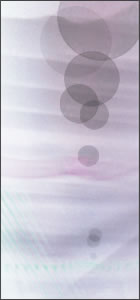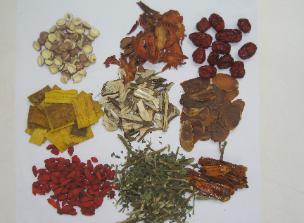


Herbal Therapy
| Yang Health Center |
warm (wen), cold (han), neutral (ping), and aromatic. The second dimension refers to the taste
property of the herb, namely sour (suan), bitter (ku), sweet (gan), spicy (xin), and salty (xian).
The various combinations of temperature and taste give the herb its properties that can influence
the yin and yang energy patterns of the body. For example, sour, bitter and salty tastes are
related to yin, whereas acrid, sweet are attributed to yang. There are herbs that will warm, herbs
that will cool, herbs that will tonify, herbs that will move stagnation and so on. It is also important
to understand that herbs do not possess one quality. They are most always a combination of
properties and temperatures and may reach one to as many as twelve organ systems. Warm
herbs can be used with individuals suffering from Heat disorders, but the herb with warm energy
must be mixed with herbs with Cool/Cold energy so that the overall balance of the mixture is on
the Cool side. Likewise, Cool herbs can be used with people with Cold disorders as long as the
overall balance of the mixture is warm. Neutral herbs are those that are neither hot nor cold, so
they are often considered gentle herbs. There are not too many neutral herbs in the
pharmacopoeia.
As for the tastes, sour constricts or consolidates. Herbs of sour taste are often indicated for use
in perspiration due to deficiency, protracted cough, chronic diarrhea, seminal and urinary
incontinences, leakage or spermatic fluid, and other conditions related to hypo-metabolism
(under-performance). In traditional Chinese medicine, they are seen as deficient or cold patterns.
Bitter possesses the function of clearing heat, purging the bowels, lowering the qi, improving
appetite and drying dampness or wetness. Bitter herbs are commonly used in fire-heat patterns,
such as the acute stage of infectious disease, and the patterns of damp-heat or damp-cold, such
as in arthritis or leucorrhoea.
Sweet has the function of toning, improving, moistening and harmonizing many of the important
systems of the body, including the digestive, respiratory, immune and endocrine systems. Sweet
tastes also relieve urgency and inhibit pain due to the constrictive action of muscles. They are
commonly used for treating deficiency patterns such as dry cough, and dysfunction of the gastro-
intestinal tract such as spleen and stomach “disharmony”.
Spicy disperses, circulates qi and vitalizes blood. This group of herbs can stimulate the sweat
glands to perspire, circulate qi, activate the function of meridians and organs and vitalize blood to
promote blood circulation. As a whole, spicy herbs have the overall effect of activating and
enhancing metabolism. Spicy herbs are commonly used in the treatment of external patterns
(catching a cold), when the function of the meridian and organs is weakened and circulation of
blood has been impeded. In traditional Chinese medical terminology, this is the stage of qi
stagnation and blood cloudiness.
Salty herbs have the function of softening firm masses and fibrous adhesions. The salty taste
purges and opens the bowels. Salty agents are often indicated in sores, inflammatory masses,
cysts, and connective tissue proliferation.
Herbal Formulas
The unique characteristic of Chinese herbal medicine is the degree to which formulation is done.
In other forms of herbal medicine, especially western herbal medicine, herbs are often delivered
singly or combined into very small formulas of herbs with the same function. In contrast, Chinese
herbalists rarely prescribe a single herb to treat a condition. They create formulas instead. A
formula usually contains at least four to twenty herbs.
Herbal formulas can be delivered in all manners of preparation. Pre-made formulas are available
as pills, tablets, capsules, powders, alcohol-extracts, water-extracts, etc. Most of these formulas
are very convenient as they do not necessitate patient preparation and are easily taken.
However, the concentration of the herbs in these products is low and don't allow the practitioner
to adjust the contents or dosages. These products are usually not as potent as the traditional
preparation of decoction.
Decoction is the traditional method of preparing herbal medicine. A decoction is a concentrated
form of tea. The practitioner weighs out a day's dosage of each herb and combines them in a
bag. A patient is given a bag for each day the herbal formula will be taken. The herbs are then
boiled in water by the patient at home. The boiling process takes from 30-60 minutes and the
resulting decoction will be consumed several times during the day.
Another modern way of delivering herbs is through granulated herbs, which are highly
concentrated powdered extracts. These powders are made by first preparing the herbs as a
traditional decoction. The decoction is then dehydrated to leave a powder residue. Practitioners
can then mix these powders together for each patient into a custom formula. The powder is then
placed in hot water to recreate the decoction. This eliminates the need to prepare the herbs at
home, but still retains much of the original decoction's potency.
property of the herb, namely sour (suan), bitter (ku), sweet (gan), spicy (xin), and salty (xian).
The various combinations of temperature and taste give the herb its properties that can influence
the yin and yang energy patterns of the body. For example, sour, bitter and salty tastes are
related to yin, whereas acrid, sweet are attributed to yang. There are herbs that will warm, herbs
that will cool, herbs that will tonify, herbs that will move stagnation and so on. It is also important
to understand that herbs do not possess one quality. They are most always a combination of
properties and temperatures and may reach one to as many as twelve organ systems. Warm
herbs can be used with individuals suffering from Heat disorders, but the herb with warm energy
must be mixed with herbs with Cool/Cold energy so that the overall balance of the mixture is on
the Cool side. Likewise, Cool herbs can be used with people with Cold disorders as long as the
overall balance of the mixture is warm. Neutral herbs are those that are neither hot nor cold, so
they are often considered gentle herbs. There are not too many neutral herbs in the
pharmacopoeia.
As for the tastes, sour constricts or consolidates. Herbs of sour taste are often indicated for use
in perspiration due to deficiency, protracted cough, chronic diarrhea, seminal and urinary
incontinences, leakage or spermatic fluid, and other conditions related to hypo-metabolism
(under-performance). In traditional Chinese medicine, they are seen as deficient or cold patterns.
Bitter possesses the function of clearing heat, purging the bowels, lowering the qi, improving
appetite and drying dampness or wetness. Bitter herbs are commonly used in fire-heat patterns,
such as the acute stage of infectious disease, and the patterns of damp-heat or damp-cold, such
as in arthritis or leucorrhoea.
Sweet has the function of toning, improving, moistening and harmonizing many of the important
systems of the body, including the digestive, respiratory, immune and endocrine systems. Sweet
tastes also relieve urgency and inhibit pain due to the constrictive action of muscles. They are
commonly used for treating deficiency patterns such as dry cough, and dysfunction of the gastro-
intestinal tract such as spleen and stomach “disharmony”.
Spicy disperses, circulates qi and vitalizes blood. This group of herbs can stimulate the sweat
glands to perspire, circulate qi, activate the function of meridians and organs and vitalize blood to
promote blood circulation. As a whole, spicy herbs have the overall effect of activating and
enhancing metabolism. Spicy herbs are commonly used in the treatment of external patterns
(catching a cold), when the function of the meridian and organs is weakened and circulation of
blood has been impeded. In traditional Chinese medical terminology, this is the stage of qi
stagnation and blood cloudiness.
Salty herbs have the function of softening firm masses and fibrous adhesions. The salty taste
purges and opens the bowels. Salty agents are often indicated in sores, inflammatory masses,
cysts, and connective tissue proliferation.
Herbal Formulas
The unique characteristic of Chinese herbal medicine is the degree to which formulation is done.
In other forms of herbal medicine, especially western herbal medicine, herbs are often delivered
singly or combined into very small formulas of herbs with the same function. In contrast, Chinese
herbalists rarely prescribe a single herb to treat a condition. They create formulas instead. A
formula usually contains at least four to twenty herbs.
Herbal formulas can be delivered in all manners of preparation. Pre-made formulas are available
as pills, tablets, capsules, powders, alcohol-extracts, water-extracts, etc. Most of these formulas
are very convenient as they do not necessitate patient preparation and are easily taken.
However, the concentration of the herbs in these products is low and don't allow the practitioner
to adjust the contents or dosages. These products are usually not as potent as the traditional
preparation of decoction.
Decoction is the traditional method of preparing herbal medicine. A decoction is a concentrated
form of tea. The practitioner weighs out a day's dosage of each herb and combines them in a
bag. A patient is given a bag for each day the herbal formula will be taken. The herbs are then
boiled in water by the patient at home. The boiling process takes from 30-60 minutes and the
resulting decoction will be consumed several times during the day.
Another modern way of delivering herbs is through granulated herbs, which are highly
concentrated powdered extracts. These powders are made by first preparing the herbs as a
traditional decoction. The decoction is then dehydrated to leave a powder residue. Practitioners
can then mix these powders together for each patient into a custom formula. The powder is then
placed in hot water to recreate the decoction. This eliminates the need to prepare the herbs at
home, but still retains much of the original decoction's potency.
major pillar of Chinese medicine. The Chinese
pharmacopoeia lists over 6,000 different medicinal
disharmonies that they were helpful with. There are
about 600 different herbs in common use today.
first dimension refers to the temperature characteristics
of the herb, namely hot (re),


Chinese Acupuncture and Spine Care
| 10640 North College Ave. Indianapolis, IN - 46280 (317)340-1427 (317)816-4006 |


